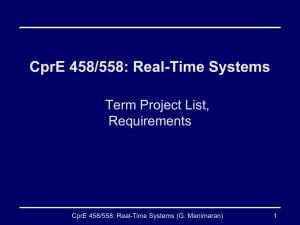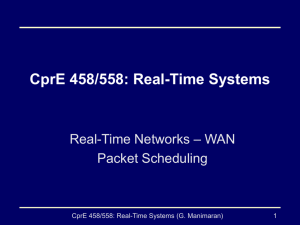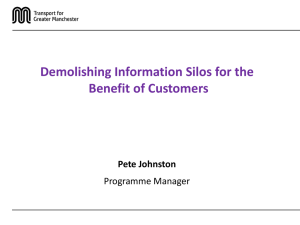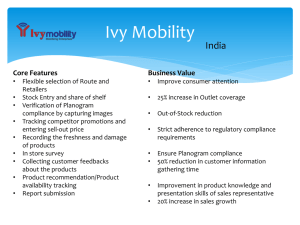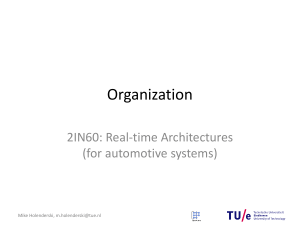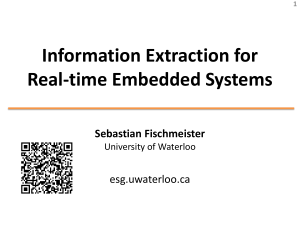CprE 458/558: Real
advertisement
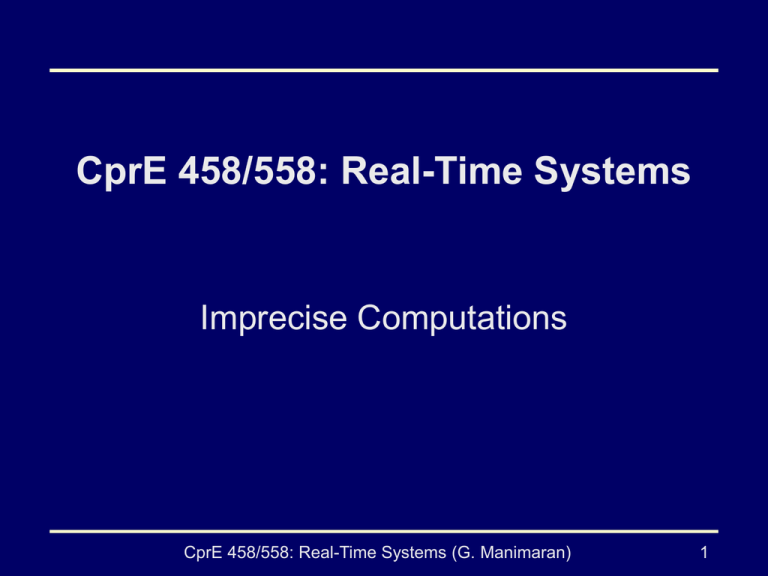
CprE 458/558: Real-Time Systems Imprecise Computations CprE 458/558: Real-Time Systems (G. Manimaran) 1 Imprecise Computational Model • A way to avoid timing faults during transient overloads and a way to introduce faulttolerance by graceful degradation is the use of Imprecise Computation (IC) technique. • The IC model provides scheduling flexibility by trading off result quality to meet task deadlines. A task is divided into a mandatory and an optional part. • The mandatory part must be completed before the task's deadline for an acceptable quality of result. CprE 458/558: Real-Time Systems (G. Manimaran) 2 Precise vs Imprecise results • The optional part, which can be skipped in order to conserve system resources, refines the result. • A task is said to have produced a precise result if it has executed its mandatory as well as optional parts before its deadline; • otherwise it is said to have produced imprecise (i.e., approximate) result when it executes the mandatory part alone. CprE 458/558: Real-Time Systems (G. Manimaran) 3 Monotone vs 0/1 constraint tasks • There are two types of imprecise computational tasks, namely, monotone tasks and 0/1 constraint tasks. • A task is monotone if the quality of its intermediate result does not decrease as it executes longer. • An imprecise task with 0/1 constraint requires the optional part to be either fully executed or not at all. CprE 458/558: Real-Time Systems (G. Manimaran) 4 Applications of Imprecise Computations • Applications are where one may prefer timely imprecise results to late precise results. • In image processing, it is often better to have frames of fuzzy images in time than perfect images. • In radar tracking, it is often better to have estimates of target locations in time than accurate location data too late. CprE 458/558: Real-Time Systems (G. Manimaran) 5 Applications (Contd’) • For example, in a tracking and control system, a transient fault may cause tracking computation to terminate prematurely and produce an approximate result. No recovery action is needed if the result still allows the system to maintain a track of its targets. • Similarly, as long as the approximate result produced by a control law computation is sufficiently accurate for the controlled system to remain stable, the fault that causes the computation to terminate prematurely can be tolerated. CprE 458/558: Real-Time Systems (G. Manimaran) 6 Error Function & Objective Functions • Monotone task, Ti: (mi, oi, di) Mandatory comp. time (mi), optional comp time (oi), deadline (di) – Error ei = F(oi – ki) where ei: Error incurred by task Ti ki: optional portion completed • Minimize the total error • Minimize the number of optional tasks discarded – Shortest processing time first strategy • Minimize the number of tardy tasks CprE 458/558: Real-Time Systems (G. Manimaran) 7 Algo F (Min Total Error, monotone task, identical weights, optimal, O(n logn)) • Treat all mandatory tasks as optional. • Use ED policy to schedule all the tasks. (St) • If a feasible schedule is found, precise schedule is obtained, stop. • Else use ED to schedule mandatory tasks. (Sm) • If feasible schedule is not found, infeasible schedule, stop. • Else use Sm as a template, transform St into an optimal schedule that is feasible and minimizes the total error. CprE 458/558: Real-Time Systems (G. Manimaran) 8 Algo F () (Cont’d) • (ED policy is a variation of EDF -- stops at deadline) • (Example: Refer to textbook, page 118) CprE 458/558: Real-Time Systems (G. Manimaran) 9 Scheduling to Minimize Total Error (for IC tasks with 0/1 constraints) • The general problem of optimal scheduling of IC tasks with 0/1 constraints is NP-complete. • Optimal schedule: A schedule in which the number of discarded optional tasks is minimum. • Special case: Optional tasks have equal comp. time – LDF algorithm • Same ready time • O(n logn) complexity – DFS algorithm • Arbitrary ready time • O(n^2) complexity CprE 458/558: Real-Time Systems (G. Manimaran) 10 Algorithm LDF • Use ED to find a schedule Sm of the mandatory tasks. • If Sm is not feasible, then task set is not feasible. • Else do the following – Use Sm as the template to obtain So (So: optimal schedule) – Use latest deadline first fashion to adjust the schedule Details of the algorithm & example: Refer to pages 119-120 in the book. CprE 458/558: Real-Time Systems (G. Manimaran) 11 Scheduling periodic tasks • Error-cumulative – Tracking and control applications • Error-non-cumulative – Image enhancement and speech processing applications CprE 458/558: Real-Time Systems (G. Manimaran) 12 (m,k)-firm deadline model • A periodic task is said to have an (m,k)-firm guarantee if it is adequate to meet the deadlines of m out of k consecutive instances of the task, where m <= k. • • • • Periodic task: (pi, ci, mi, ki) A flexible method for expressing timing requirements. Allows “graceful degradation” during overloads. Choose values for m and k such that desired m/k is obtained. • (1,1)-firm hard real-time task. • Apps: Radar tracking, Automobile control • (m,k) vs. imprecise computation (IC): In (m,k) model instances can be dropped in full; in IC, portion of a instance can be dropped. CprE 458/558: Real-Time Systems (G. Manimaran) 13 References • J.W.S. Liu, K.J. Lin, W.K. Shih, A.C. Yu, J.Y.Chung, and W. Zhao, “Algorithms for scheduling imprecise computations,” IEEE Computer, vol.24, no.5, pp.58-68, May 1991. • P. Ramanathan, “Graceful degradation in realtime control applications using (m,k)-firm guarantee,” In Proc. of Fault-Tolerant Computing Symposium, pp.132-141, 1997. CprE 458/558: Real-Time Systems (G. Manimaran) 14
